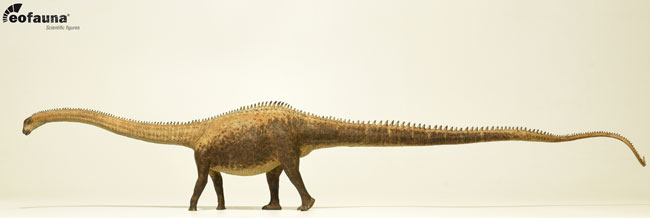A recent study published in the academic journal “Scientific Reports” refutes the idea that some long-necked herbivores had supersonic sauropod tails. The controversial idea that some dinosaurs could lash their tails like a whip creating a supersonic crack as the tail travelled faster than the speed of sound has been refuted in newly published research. Instead, the researchers suggest that the tail of diplodocids such as Apatosaurus, Brontosaurus and Diplodocus could still play a role in defence, producing a painful blow to deter an attacker. It is also suggested that these long, whip-like tails could have been used in intraspecific combat.

Picture credit: Everything Dinosaur
Supersonic Sauropod Tails
A sauropod clade, the Flagellicaudata are characterised by their extremely long tails. This clade includes the Diplodocidae family and the closely related Dicraeosauridae. Although complete fossil sauropod tails are extremely rare, palaeontologists have a good idea of the anatomy of a typical diplodocid tail. It consisted of approximately eighty caudal vertebrae, that gradually decrease in size and morphological complexity towards the tail tip. There are approximately ten larger posterior vertebrae, followed by forty or so intermediate bones with finally around thirty progressively smaller rod-like caudal vertebrae.
Earlier studies had suggested that the tail could be whipped, and the tip would travel so fast (in excess of 500 metres per second), this action would break the sound barrier and produce a loud sound. This speedy tail would cause a significant injury should it come into contact with another dinosaur.
However, this new study used three-dimensional models and computer analysis to assess the stress on the bones, ligaments and soft tissues. They concluded that the maximum tip velocity generated would be around thirty metres a second, nowhere near the 330 metres per second required to break the sound barrier.

The picture (above) shows the recently introduced Eofauna Scientific Research Diplodocus carnegii replica. When shown in lateral view, the extremely long tail can be seen.
To view the range of models and figures in the Eofauna series: Eofauna Scientific Research Models.
An Effective Weapon
Whilst the researchers conclude that the effect of friction on the musculature and aerodynamic drag would prevent the tail tip from reaching a speed capable of breaking the sound barrier, the pressure applied by the terminal section would not be enough to break bones or lacerate dinosaur skin, but it could still deliver a painful blow.
In summary, the scientists suggest that sauropod tail use remains speculative, these tails could have been used in intraspecific combat, or perhaps as a weapon against predators. Similarly, the use of the tail as a tactile element to retain herd cohesion is equally plausible.
The scientific paper: “Multibody analysis and soft tissue strength refute supersonic dinosaur tail” by Simone Conti, Emanuel Tschopp, Octávio Mateus, Andrea Zanoni, Pierangelo Masarati and Giuseppe Sala published in Scientific Reports.






Leave A Comment